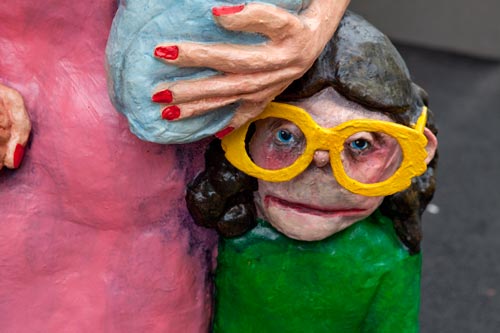 |
|||||
Lucerne, Switzerland - 2009 - Num 21 Mpx - 5d2_4853 - series Photo of the week |
| Home | Using | Themes | 900 photos | Weekly Photos |
|
Glasses, stand for the sight, is regrettably an almost compulsory accessory at the moment (or at any time) of the life. This universal object is not however easy to illustrate.
So except Graph' wall (see the series) or the other street entertainments, and the engravings of time, the essential pivot of this display of glasses results from a sculpture seen in Lucerne, placed in front of the Central store Optic of Lucerne, and the owners of which kindly authorized me to use them here, by preferring however to keep confidential the name of the artist sculptor.
What we said about it in 1690 in the dictionary of Furetière : Glasses, in the plural, are two glasses set in the horn, or the other material, than we apply down at the bows and in front of eyes, to help to the old men, and to those who are short-sighted, to read and to write, or to discover better objects. We also call them glasses. There is which serve to enlarge objects, the others to preserve only the sight, which we call cans of food. We also made glasses for long sight, to apply to both eyes, which we call lorgnettes, of which wrote Father Cherubin Capucin, and before him Father Rheita of the same Order, in its entitled Book, Oculus Enoch and Eliae, who had also found the invention of glasses for three or in four glasses. To finish the perfection of glasses, we found the means to apply a wire-mesh or a railing of very-loose nets to the convex eye glass; what returns the more just observation. We see the figure in the Newspaper of the Scholars of year 1667. Glasses were certainly unknown in the Former ; but also they are not so modern as the telescope. Franceico Reddi claims that the invention was found there in the XIIIth century since the year 1280 until 1311 and that Brother Alexandre Delpina of the order of the Preaching friars of St. Catherine de Pise, who died from the year 1313 communicated the invention, whom he found of himself(itself), after he had learnt that the other one had found the secret, which he did not want to communicate. It is written in the Chronicle of this Convent. He still says, that in an old Manuscript consisted in 1299 which he has among his Books, he is spoken about glasses as about thing invented at that time: that a famous Jacobin, named Jourdan de Rivalto in a Treaty which he composed in 1305 said expressly which there was not another 20 years when glasses were found. He still quotes Bernard Cordon in his Book of Lillium Medicinae, consisted in the same year, when he speaks about an eye drops which was good to make read an old man without glasses. Of said Cange that there is a Greek Poem which is in manuscript in the Library of the Roy, which shows that glasses were used from the year 1150. And it is mentioned these glasses in the Dictionary of Crusca in the word Occhiale. Year 1363 is also mentioned it in the Book of Guy de Chauliac Professor of Medicine in Montpelier, entitled the Big Surgery, consisted dice. There is also a ruling of November 12th, 1416 reported by Ménage in the Book Amoenitates Juris, which mentions these glasses; and other former testimonies quote by Sr. Comiers in his Treaty of glasses, after Mr. Redi Médecin Italien who wrote it very learnedly.
Below, the other article and the engravings of former
Photography of the week 50 of 2012
|
| General presentation | The same in french : Lunettes à tous âges |
|
|
Former glasses Chinese
We could draw up a list curious about all the useful discoveries which made the Chinese, without they seem to have been guided by the slightest scientific knowledge. Without knowing a single point of the theory of the optics, which deals with the convergence and with the difference of the beams of the light by means of lenses of various forms, they use(get) glasses or rather convex and concave crystals to help the sight.
Other engravings of former glasses
|
| Previous series : Autumn weather | Following series : Christmas markets |
![]()
Deposite of Copyright against any commercial use
Photos, texts and/or reproductions published on this site
See explanations on the page "Using"
| Plan de site | Recherches | Qualité | Liens |